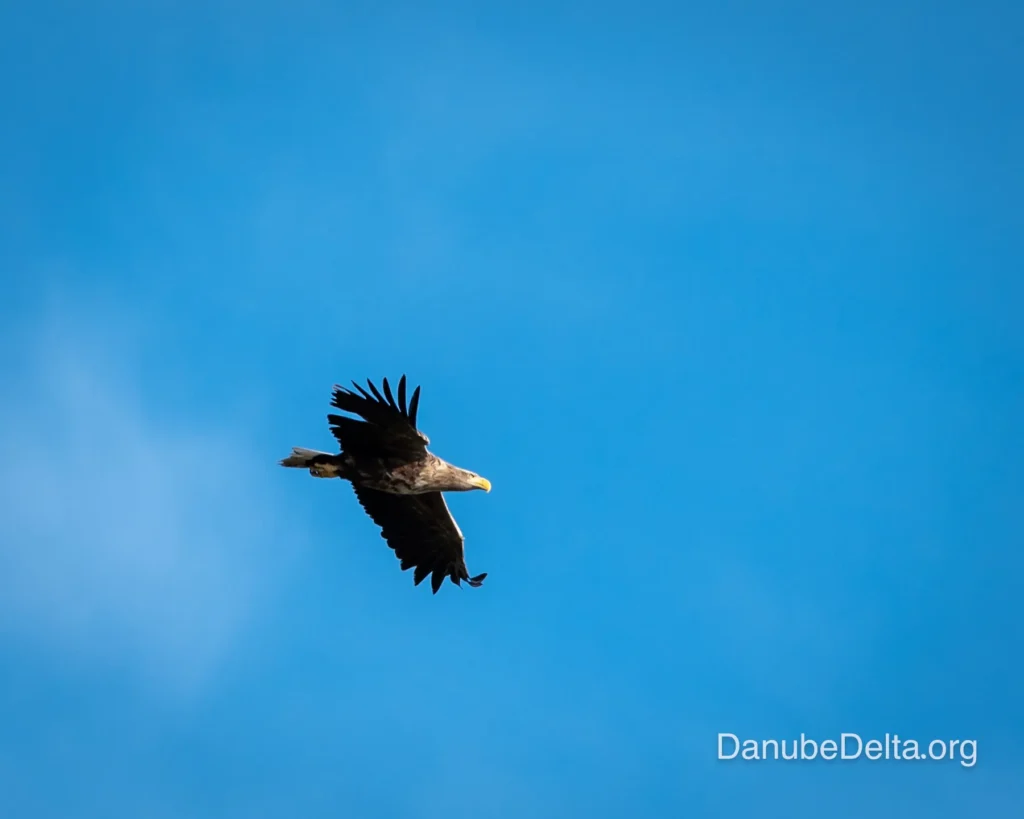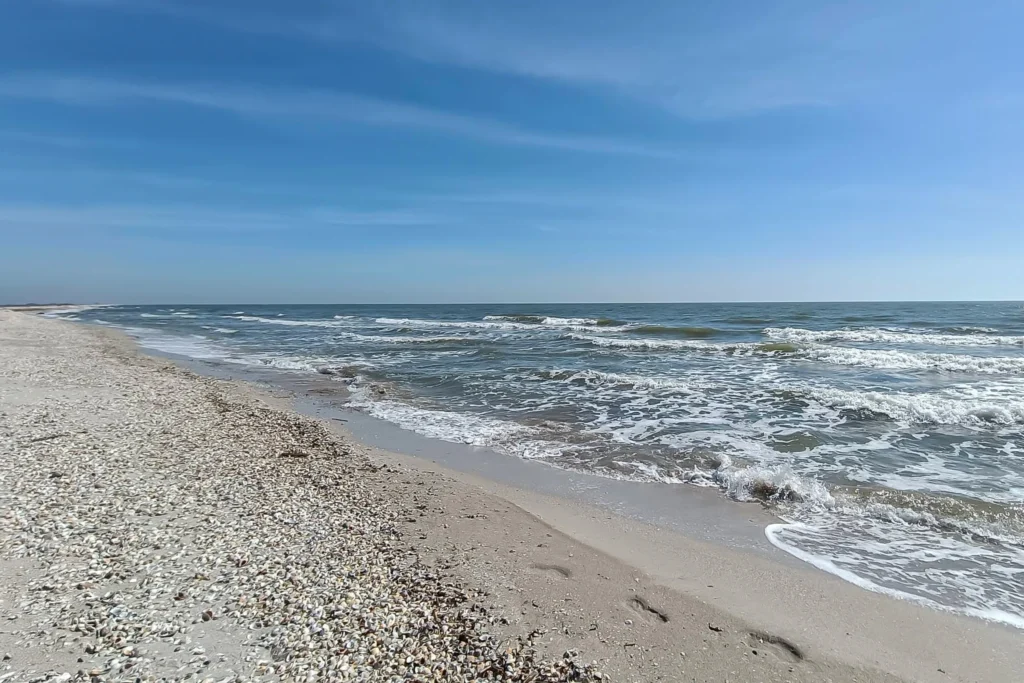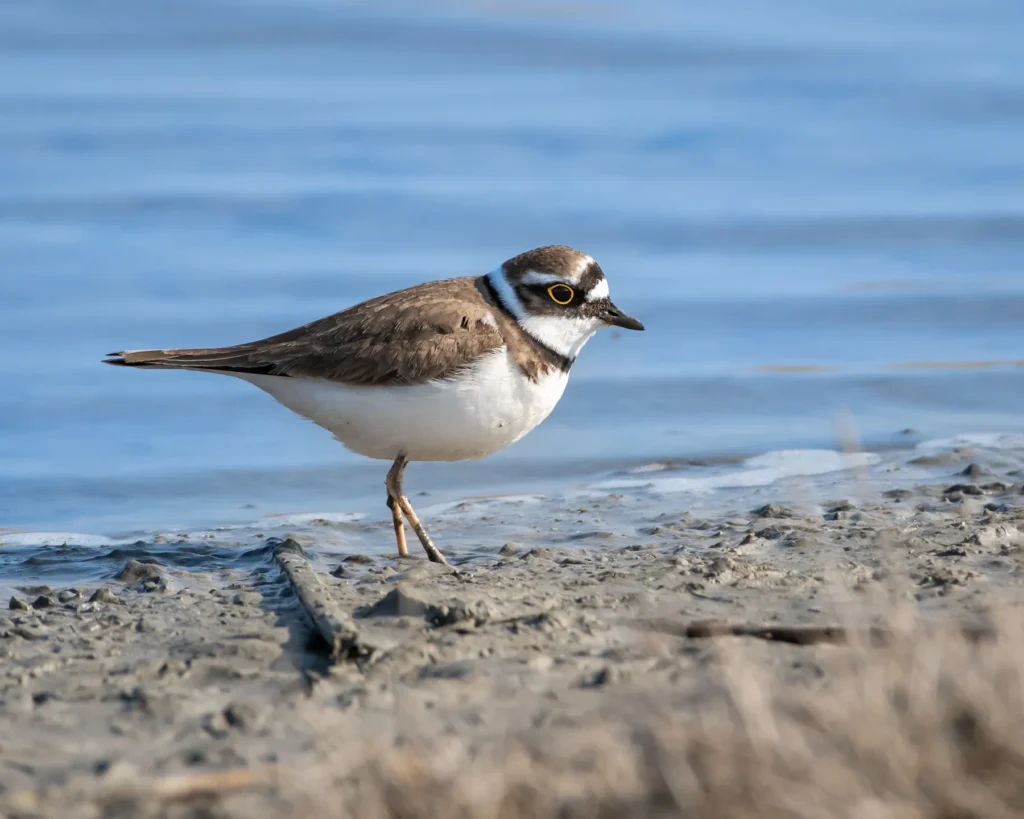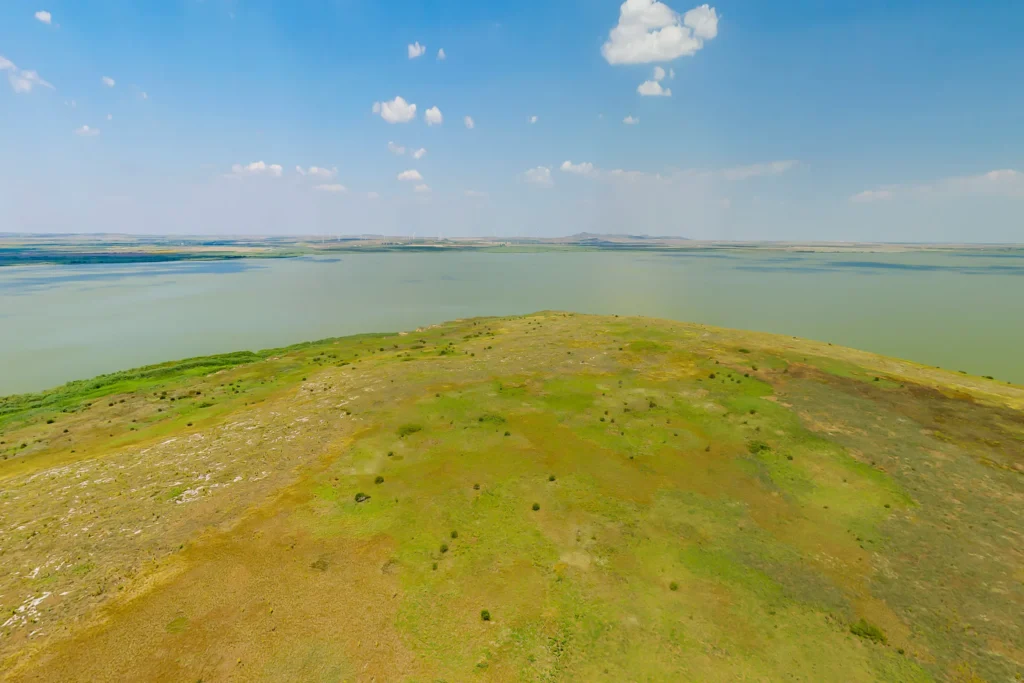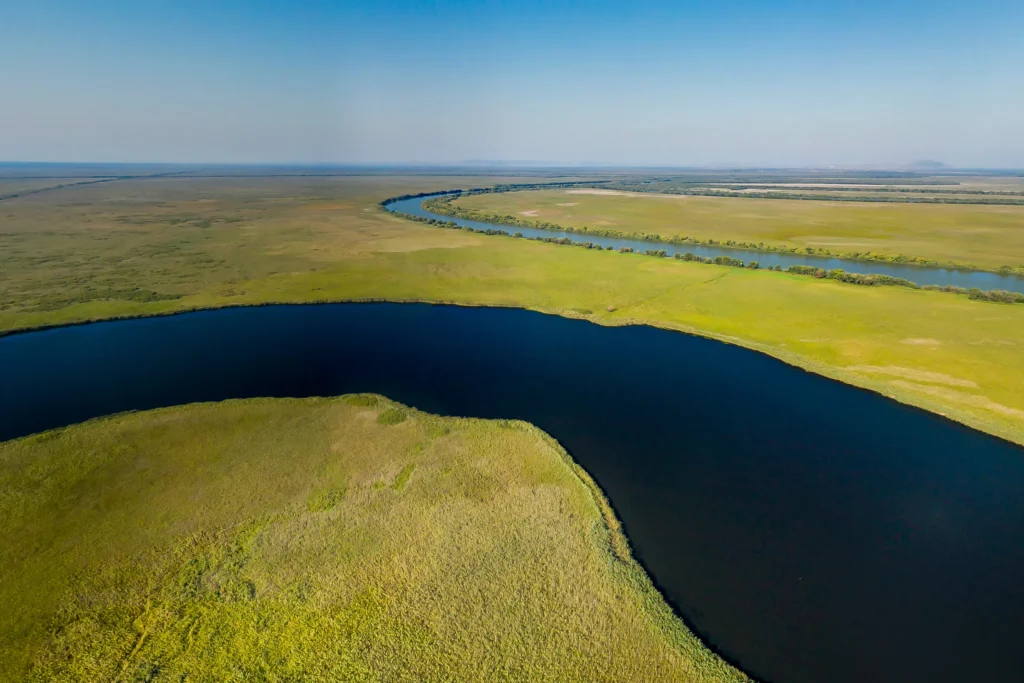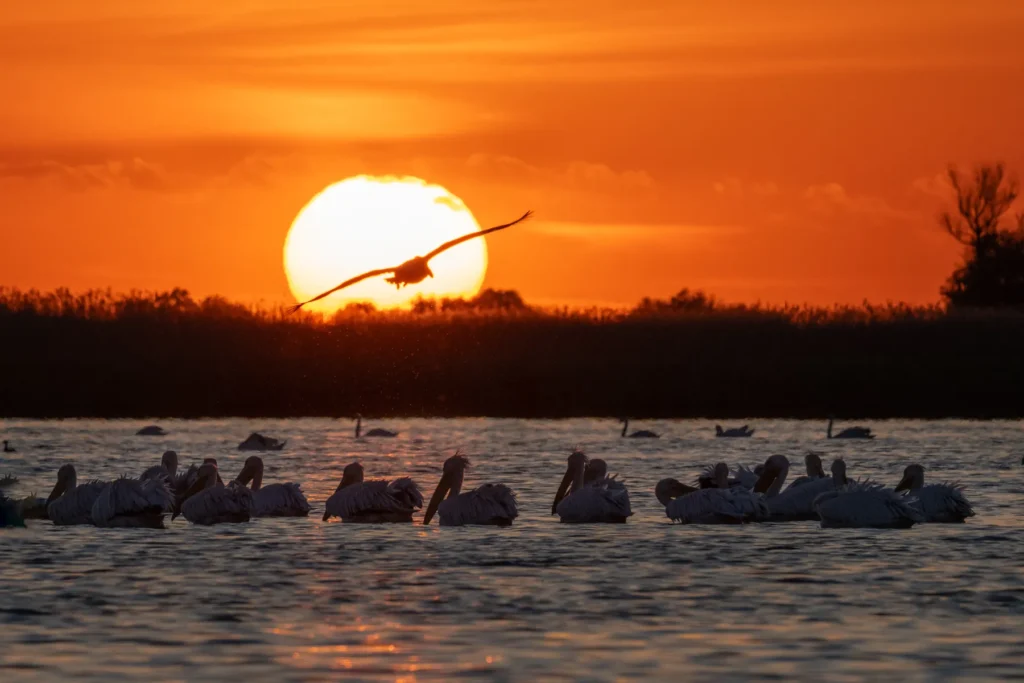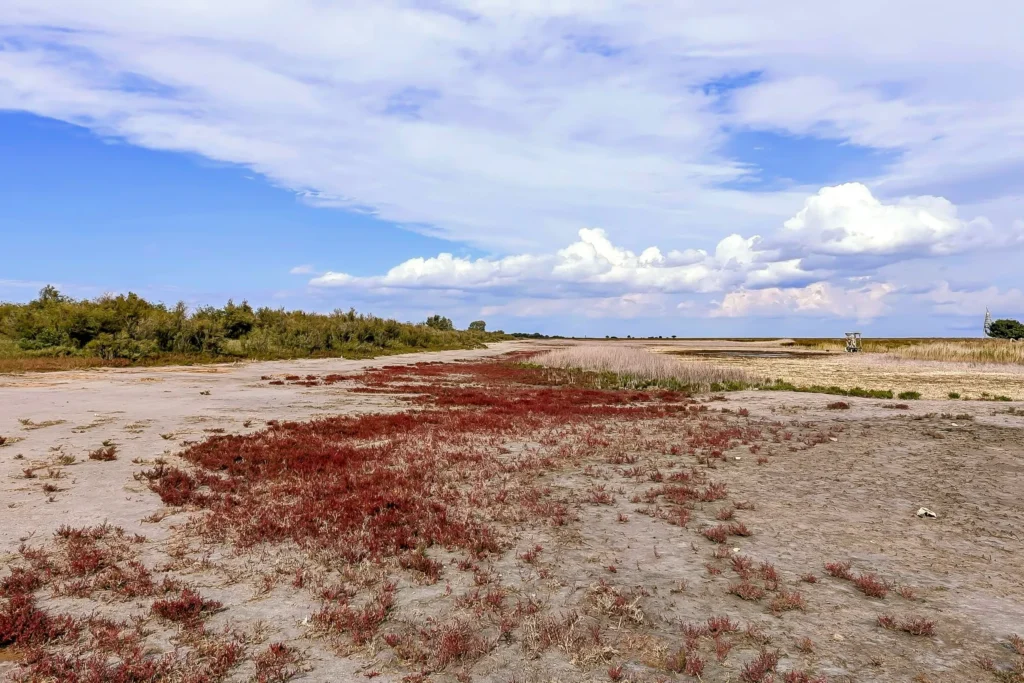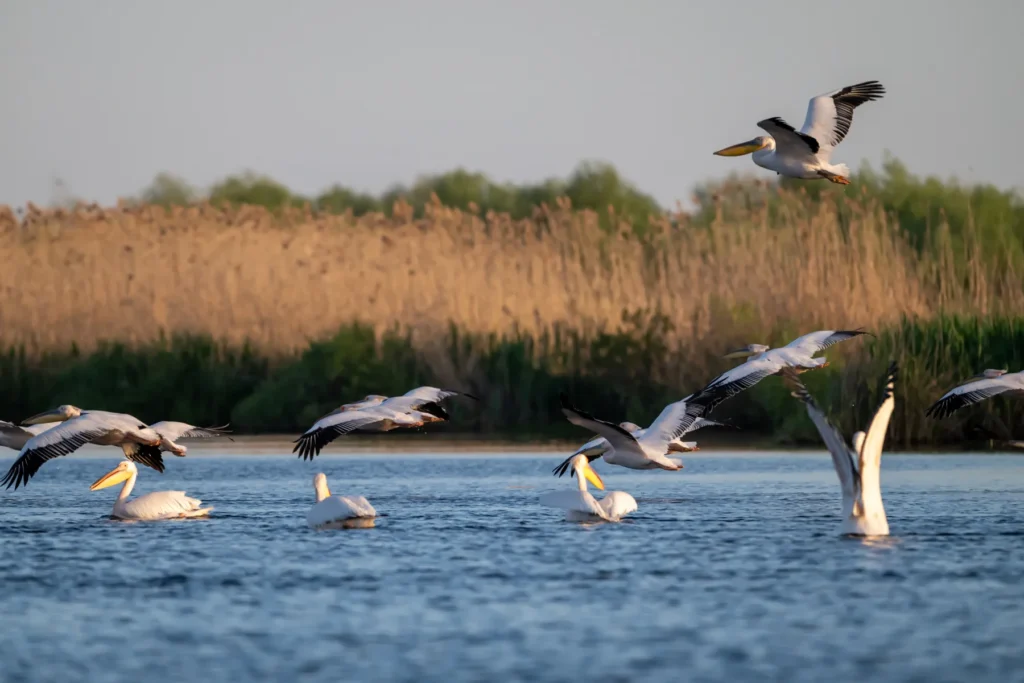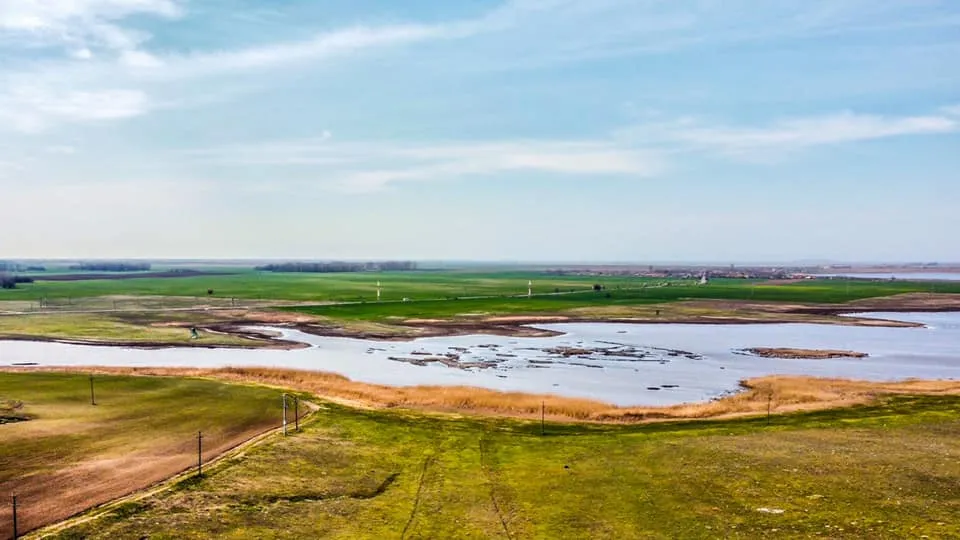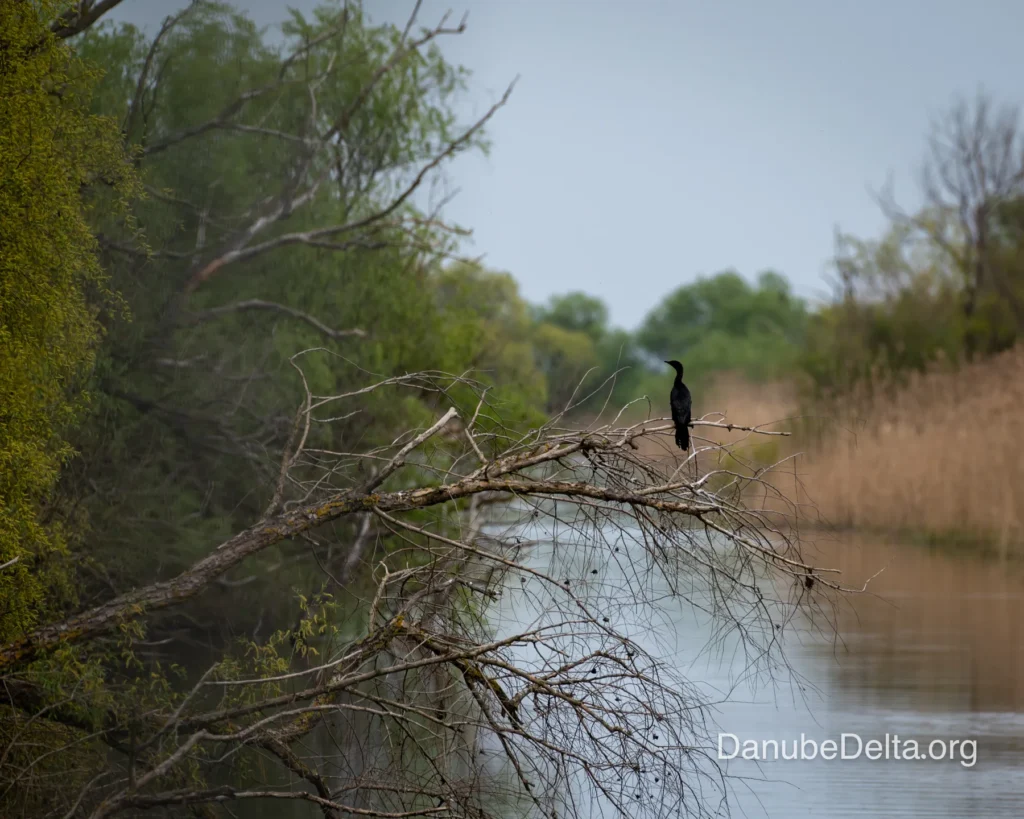Chituc Grindul, a strictly protected area in the Danube Delta
Chituc Grindul - Danube Delta
Chituc Grindul
The Chituc Grind, a strip of land of particular ecological and geomorphological importance, is a vital component of the Romanian coastal landscape. Strategically located between the lagoon waters of the Razelm-Sinoe complex and the Black Sea, this maritime grindstone is not only a natural barrier but also a dynamic ecosystem, recognised nationally and internationally for its exceptional conservation value. This area provides an essential habitat for rich biodiversity, especially for birdlife, and has unique geological features which underline its fragility and the urgent need for its protection.
Definition and Geographical Location
The Chituc Ridge is defined as a maritime ridge, a strip of sand that naturally separates the waters of Lake Sinoe (part of the Razelm-Sinoe lagoon complex) from the Black Sea. This geographical feature is crucial for the hydrological balance of the lagoon system. Grindul is located in Constanța County, Romania, mainly in the administrative territory of the municipality of Corbu, the nearest town being Năvodari. It stretches between Gura Portiței and Capul Midia.
In terms of size, the Chituc Grind is about 27 km long, with an average width of 1-2 km, reaching a maximum of about 4 km, and a height that usually varies between 1.5 and 2 metres. The total area of the Chituc Grind is 7,300 hectares, of which a strictly protected area of 2,300 hectares lies in the northern part.
A distinctive feature of the Chituc Grind is the presence in its north of about seven places where the boundary between the lagoon and the sea has an intermittent natural character. Where the strip of sand is narrow and not very high, strong storms can open mouths of communication between the sea and lagoon waters. This feature is not simply a geographical fact, but emphasises a crucial dynamic hydrological process. The intermittent connection means that salinity and water exchange between the lagoon and the sea are not constant, which directly influences the unique brackish ecosystems of Lake Sinoe and the lagoon complex. This dynamic is a key ecological driver and point of vulnerability, as human intervention or climate change (such as sea level rise or storm intensification) could alter this delicate balance, affecting flora and fauna adapted to these fluctuating conditions. It also involves a natural 'self-regulating' mechanism that allows for periodic flushing or saline intrusion, contributing to the biodiversity of the area.
Context in the Romanian Littoral Landscape
Grindul Chituc is part of the Danube Delta Biosphere Reserve (DBRD), located in the southernmost part of the Danube Delta. It is considered to be one of the last wild and undeveloped stretches of beach on the Romanian coastline, with no building permits issued. Its sand is still unpolluted by shells and algae, preserving its natural character.
The description of the Chituc Grind as "one of the last remaining segments of wild beach in the country" is more than just a descriptive phrase; it is a statement of its rarity and high conservation value. In a highly developed coastal region such as the Romanian Black Sea littoral, the existence of such an untouched area is of immense ecological significance, serving as a refuge for species and natural processes. This rarity intrinsically increases its importance beyond its protected area status, making its conservation a critical imperative for the national natural heritage. It also lends a strong tone to the report, emphasising why detailed information and strict regulation are needed.
Status of International Protection and Importance
This section details the multi-level protected status of the Chituc Grind, emphasising its significance at national and international level.
Protected Area of National Interest (IUCN Category IV)
Grindul Chituc was established as a protected area of national interest in 1961. It corresponds to IUCN category IV (Habitat/Species Management Area), which indicates that its main purpose is to maintain specific habitats and/or fulfil the requirements of specific species. The protected area specifically includes typical coastal sandy sand habitats, very little affected by anthropogenic activities, and aquatic habitats undisturbed by man. Its national legal status is consolidated by H.G. No 248/1994 and confirmed by H.G. No 230/2003, which delimits protected areas.
Part of the Danube Delta Biosphere Reserve (Danube Delta Biosphere Reserve)
With an area of 2,300 hectares, the Chituc Grind is included in the perimeter of the Danube Delta Biosphere Reserve (DDBBR) and is one of its 20 strictly protected areas. Within the RBDD, the strictly protected areas, totalling 50,904 hectares (8.7% of the reserve area), are considered representative samples of natural terrestrial and aquatic ecosystems and are subject to mandatory protection. They are surrounded by buffer zones and sustainable development zones, which help to mitigate anthropogenic impacts.
Additional International Recognition (SPA, SCI)
The Chituc Grindul, as part of the RBDD, benefits from major international recognition. The Danube Delta Biosphere Reserve was declared a UNESCO Biosphere Reserve (UNESCO MAB, code ROMAB0003) in 1990, a Ramsar Site (wetland of international importance) in 1991 and a UNESCO Universal Natural Heritage Site (code 588) also in 1991. In addition, the Chituc Grind is included in the Natura 2000 network, as ROSCI0065 (Site of Community Importance - SCI) and ROSPA0031 (Special Avifauna Protection Area - SPA) The Grind is also declared a Special Avifauna Protection Area, emphasising its critical role for birds.
The high number of national and international protection designations (IUCN Category IV, National Protected Area, Strictly Protected Area within the RBDD, UNESCO Biosphere Reserve, Ramsar Site, UNESCO World Heritage Site, Natura 2000 SPA/SCI Site) emphasises the immense global ecological value of the Chituc Grind. This stratification of protection is not just multiple designations, but a recognition of global consensus on its outstanding universal value. The implication is that any threat to the Chituc Grind is not just a local or national issue, but a matter of international concern, potentially affecting Romania's compliance with global conservation treaties and its reputation as a custodian of natural heritage. This multi-level protection also implies a more complex governance and monitoring framework involving national and international bodies.
Its designation as a Special Avifauna Protection Area (SPA) and an important passage and wintering area for birds means that the Chituc Grind is not an isolated ecological unit. It is a vital link in the wider migratory flyways of birds from Europe, Asia and Africa. It emphasises a critical ecological connectivity - the health of the Chituc Grind directly influences bird populations far beyond Romania's borders. Conservation efforts must therefore take into account these migratory patterns and the wider network of protected areas.
Table 1: Chituc Grind - Key Characteristics and Protected Status
| Feature / Status | Detail |
| Localisation | Constanta county, Corbu commune, Romania; between Gura Portiței and Capul Midia |
| Nearest city | Năvodari |
| Length | About 27 kilometres |
| Average / maximum width | 1-2 km / 4 km |
| Height | 1.5-2 m |
| Total surface area | 7 300 ha |
| Strictly protected area | 2,300 ha |
| Year of establishment as a protected area | 1961 |
| IUCN categories | Category IV (Habitat/Species Management Area) |
| National Statute | Strictly protected area by H.G. No 248/1994 and H.G. No 230/2003 |
| Part of RBDD | Yes, one of the 20 strictly protected areas |
| International Recognition | UNESCO Biosphere Reserve (1990), Ramsar Site (1991), UNESCO Universal Natural Heritage Site (1991), Natura 2000 Site (ROSCI0065, ROSPA0031) |
Geology and Geomorphology: Formation and Physical Features
This section analyses the geological history and physical formation of the Chituc Grind, explaining its dynamic nature.
Geological History and Formation Processes
The timing of the formation of the Chituc Grind is controversial, with arguments suggesting a range between the 2nd-3rd and 9th-10th centuries B.C. Other studies suggest a period of formation between the 2nd and 3rd centuries B.C. or the 6th century A.D., with the earliest grind dating to around 700 A.D. The grind began to form by the gradual joining of new series of littoral ridges to the old ones, being basically the result of the joining of different shore lines in several stages (called Chituc I-V, according to Panin N, 2004). Its construction is due to the eroded material from the Delta developed at Portița (Sinoe Delta), which was moved by the coastal currents and waves immediately to the south. The Chituc Grind is unanimously considered the youngest marine formation in the area, due to its position closest to the sea and the lack of archaeological traces.
The controversial and relatively recent period of its formation (2nd-10th centuries AD), together with the description of its formation by "the gradual joining of new series of littoral ridges", indicates that the Chituc Ridge is a young and dynamic geological feature. It is not a static landform, but one that has been continuously shaped by marine processes (erosion, transport, deposition). This understanding is crucial because it suggests an inherent instability and vulnerability to sea level change, storm intensity and sediment input from the Danube, making it particularly susceptible to the impacts of climate change and coastal erosion. Its youth also explains its 'lack of archaeological traces', reinforcing its natural, unspoilt character.
Dimensions and Morphology
As mentioned, the Chituc Grind is approximately 27 km long, 1-2 km wide (with a maximum of 4 km) and 1.5-2 m high. The morphological configuration of the area is characterised by successions of small, predominantly cordans, dunes and lakes, oriented obliquely to the present shoreline and fan-shaped.
The littoral sands in this area are of mixed origin: either fluvial, carried out to sea by the Danube, or produced by marine abrasion processes, due to the combined action of waves and coastal currents. Sometimes these sands can also be modelled by wind, resulting in a micro-relief of dunes. The depiction of 'successions of chords, dunes and lakes' with a 'fan-like arrangement' goes beyond simple dimensions. It paints the picture of a complex geomorphological mosaic. This varied micro-relief, shaped by both marine and aeolian processes, creates a diverse range of micro-habitats. This directly explains the rich biodiversity found here, as different species can occupy specific niches within this varied landscape. Understanding this complexity is vital for effective conservation, as disturbance of one element (e.g. dunes) can have cascading effects on the whole ecosystem.
Biodiversity: Flora, Fauna and Habitats
This section presents the rich biodiversity of the Chituc Grind, detailing flora and fauna species and protected habitats.
Overall Ecological Importance
The Chituc Grind is an important passage and wintering area for birds. The area consists of a cluster of small lakes, which are particularly important for bird migration and wintering. The conservation value of this area is considered very high.
Characteristic and Protected Fauna Species
The faunal diversity of the Chituc Grind is remarkable:
- Birds: 148 bird species have been observed or are potentially present, of which 92 are mentioned in the Emergency Ordinance No 57 of 20 June 2007 on the regime of protected natural areas, the conservation of natural habitats, wild flora and fauna. Of these, 49 species are included in ANNEX 3, requiring conservation measures. Chituc Grind lies on one of the most important bird migration routes in Europe, Asia and Africa. Of particular importance is the fact that the Vadu-Corbu beaches on the Chituc Ridge are the only remaining nesting site of the RBDD where the red-rumped plover (Greater Pratincole).
- Mammals: This is the only area where jackals can still be found. Measures are in place to limit the damage caused by jackals in the Danube Delta Biosphere Reserve and the immediate neighbouring area.
- Reptiles and Amphibians: The vegetation is characteristic of coastal areas and harbours the sand lizard (Eremias arguta deserti), which is present here in large numbers. Field investigations in the area revealed distributional and ecological data for 9 species of amphibians and reptiles, including some species of special conservation concern.
- Ichthyofauna (Fish): The fish ichthyofauna of the Romanian littoral shows notable changes, especially in the number of individuals in specific populations.
- Nevertebrates (Zooplankton and Meiobentos): Diatoms identified include Skeletonema costatum and Delicate pseudo-nitzschiaand cyanobacteria such as Pseudoanabaena limnetica have had significant developments.
The observation that zooplankton species showed an overall declining trend between 2007 and 2012 , together with the presence of non-indigenous species, are critical indicators of ecosystem health and potential stress. This suggests that even highly protected areas are not immune to wider environmental pressures such as climate change, pollution or invasive species. This emphasises the need for continuous long-term monitoring and adaptive management strategies to counter these trends.
Specific Flora and Habitats
The vegetation on the Chituc Grind is characteristic of coastal areas with sandy depleted soil. This vegetation is of great importance for bird migration and wintering. The area hosts Natura 2000 habitats of very high conservation value, including:
- 2110 Embryonic mobile dunes: They provide a first stage of fixation of marine sands and harbour rarer species such as the perch (Leymus racemosus subsp. sabulosus), the sand pellet (Artemisia tschernieviana) and vitrigon (Eryngium maritimum).
- 2130 Fixed coastal dunes with herbaceous vegetation ('grey dunes'):* They are populated mainly by herbaceous perennials and harbour many rare flora.
On the Chituc Grind, 5 species of flora are endangered and 106 species are included in the unfavourable status category. Under the Habitats Directive (Law 462/2001), 4 habitat types and 90 animal species are required to be declared special areas of conservation, the same Directive gives strict protection status to 80 species and 57 species are considered of special concern.
Table 2: Key Wildlife Species and Protected Habitats
| Categories | Species/Habitat Example | Status/Importance |
| Birdlife | Rusty Ciovlica (Greater Pratincole) | Nest only here in RBDD; vital passage and wintering area; 148 species, 92 protected |
| Mammals | Jackal | The only place in the RBDD where it still meets |
| Reptile | Sand lizard (Eremias arguta deserti) | Present in large numbers; 9 amphibian/reptile species identified |
| Ichthyofauna | Sprout, anchovy, horse mackerel, Danube mackerel, common dentex, mullet, mullet, sea bass, red catfish, etc. | High diversity, including species of commercial interest |
| Nevertebrate | Aurelia aurita, Rhizostoma pulmo, Mnemiopsis leidyi, Beroe ovata, Chamelea hen, Liocarcinus vernalis | Zooplanktonic and meiobenthic diversity; presence of non-indigenous species; decline in zooplankton species numbers |
| Specific flora | Perișor (Leymus racemosus subsp. sabulosus), the sand pellet (Artemisia tschernieviana), vitrigon (Eryngium maritimum) | Rare dune species |
| Natura 2000 habitats | 2110 Mobile embryonic dunes, 2130* Fixed coastal dunes with herbaceous vegetation ('grey dunes') | Very high conservation value; essential for sand fixation and biodiversity |
Threats and Conservation Efforts
This section looks at the challenges facing the Chituc Grind and efforts to protect it.
Major Threats to Biodiversity
Despite its high protection status, the Chituc Gorge faces significant threats, mainly man-made.
- Anthropogenic fires: Wildfires are a recurring and devastating problem. For example, in the autumn of 2022, over 700 hectares of vegetation burned in the Chituc Grind area for almost 20 hours, with reignited fires requiring difficult interventions. These fires are often attributed to deliberate local actions, with various motivations, such as clearing land for grazing, preparing the grind for the construction of fishing shelters or harvesting reeds. The impact on wildlife is severe, leading to the incineration of animals, although some officials have downplayed the effects, claiming that migratory birds would have already left. However, the presence of passerine ringing birds at the time indicates that many species were still present and vulnerable. In cases of major fires, criminal cases were opened.
- Industrial Development Projects: A major contemporary threat is Hidroelectrica's proposed development of a 300 MW wind project on land in the Grindului Chituc area. This project, although promoted as a green energy solution, has sparked strong opposition from over 20 environmental organisations. They have called on the ministries of environment, energy and agriculture not to allow the project to be developed in the Danube Delta Biosphere Reserve, considering it inappropriate to locate the wind farm in an area of crucial importance for birdlife and within protected natural areas or buffer zones. The organisations stress the need for strict environmental impact assessment processes and avoidance of key biodiversity areas. Category A wind projects can have significant and negative environmental and/or social impacts.
- General Anthropogenic Impacts: In addition to arson and large-scale development proposals, anthropogenic pressures also include phenomena such as road mortality of wildlife, including reptiles such as Dolichophis caspius, which may be affected by existing or future infrastructure.
Recurring fires, driven by local socio-economic activities, and proposals for industrial development represent a fundamental conflict between human needs/economic interests and the protected area status of the area. This demonstrates that legal protection, while essential, is not sufficient without addressing the root causes of degradation and promoting sustainable alternatives. This emphasises the need for integrated land use planning, involvement of local communities and rigorous law enforcement.
Conservation and Monitoring Efforts
Despite the threats, there are active efforts to conserve and monitor biodiversity on the Chituc Grind.
- Bird Ringing Camp: A key initiative is the Bird Ringing Camp, which has been running for 12 years in its current format. It collects essential data on songbird migration and had a successful year in 2023, involving 180 volunteers. The work of the camp contributes to the study, conservation and monitoring of the country's bird populations.
- Research and Conservation: Organisations such as the Milvus Group are involved in research and conservation projects on mammals and birds of prey, as well as in activities to implement the Natura 2000 network in Romania. These efforts contribute to a better understanding of the ecosystem and to the development of effective conservation strategies.
Visitors Guide and Regulations
This section provides practical information for visitors to the Chituc Grind, detailing access rules and applicable fees.
Access and Traffic
Grindul Chituc, although a wild and attractive beach, is located in a strictly protected area, which imposes strict access and traffic rules. Car access and camping are strictly forbidden and punishable by fines. In fact, car access to the Chituc Grind has been completely restricted after ARBDD representatives failed to prevent car access to the Grind's canopy by controlling access. Tourists are urged to respect the rules on access and circulation by boat or road on the territory of the Danube Delta Biosphere Reserve, according to H.G. 538/2015.
The strict regulations on car access and camping, despite the area's attractiveness as a 'wild beach', are a direct consequence of its high protection status. This illustrates the necessary trade-off between allowing the public to enjoy the natural beauty and protecting fragile ecosystems from human disturbance. It underlines the importance of educating visitors to ensure compliance and minimise negative impacts.
Permits and Fees
In order to visit the Chituc Grind, as part of the Danube Delta Biosphere Reserve, it is necessary to pay for permits, which can be obtained at the headquarters of the Administration of the Danube Delta Biosphere Reserve (ARBDD), the ARBDD Information Centres, the permit issuing machines in Tulcea or the surrounding localities, online at permise.ddbra.ro, or by SMS to the number 7494.
Certain categories of people benefit from free access to the reserve and for boats, including children, schoolchildren, students, pensioners, war veterans, former political prisoners, people with disabilities and individuals who live in the reserve or neighbouring localities.
Recommendations for Visitors
For a responsible and enjoyable experience, visitors are recommended:
- Enjoy walks on set tourist trails and bird watching.
- Bring cameras to immortalise the unique flora and fauna.
- Rely on tinned food, fruit and veg if they choose to bring their own.
- Make sure they don't forget their rubbish bags and take all their rubbish home or to a designated collection point.
- Wear comfortable footwear.
Conclusions
Grindul Chituc is a natural heritage of inestimable value for Romania and the world. Its unique geomorphological features, its status as a strictly protected area within the Danube Delta Biosphere Reserve and its international recognition through UNESCO, Ramsar and Natura 2000 underline its exceptional ecological importance. It is a vital refuge for remarkable biodiversity, particularly for birdlife, serving as a key point on migratory routes and harbouring rare and endemic species.
However, the Chituc Grind faces significant challenges, particularly from anthropogenic pressures. Recurring fires, often caused by human activities, continue to degrade habitats, and proposals for industrial development such as wind farms threaten to disrupt the fragile balance of the ecosystem. These threats demonstrate that despite high levels of legal protection, rigorous enforcement, adaptive management and active involvement of local communities are essential to ensure effective conservation.
Conservation efforts such as bird ringing camps and scientific monitoring are crucial to understanding and protecting this area. For visitors, strict adherence to access regulations and the principles of responsible tourism are fundamental to minimising human impact and allowing the wild character and biodiversity of the Chituc Grind to be perpetuated.
Overall, the Chituc Gorge is a shining example of the delicate balance between conservation and human interaction. Its future depends on continued conservation efforts, sustainable management and public awareness to ensure that it remains a vital natural heritage site for future generations.
Events in the Danube Delta
Accommodation to suit all tastes:
Whether you prefer the cosiness of modern villas, the rustic atmosphere of traditional guesthouses or the adventure of camping, they offer a variety of accommodation options to suit your needs and budget.
